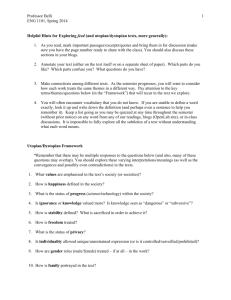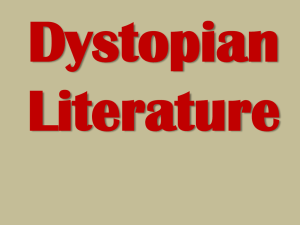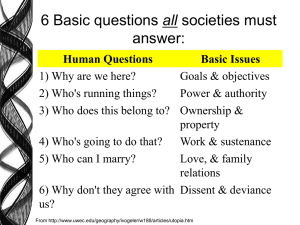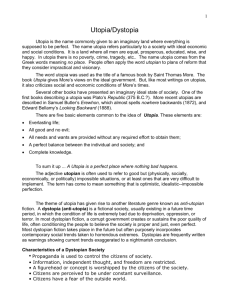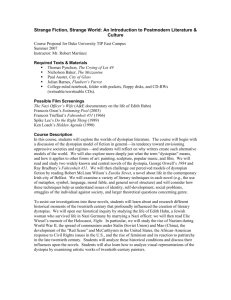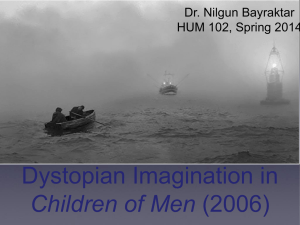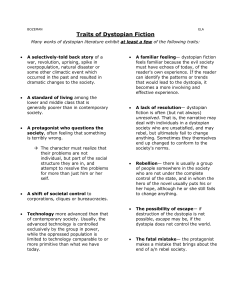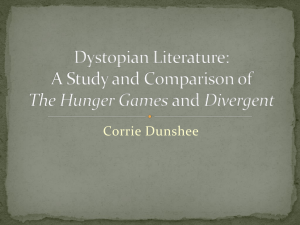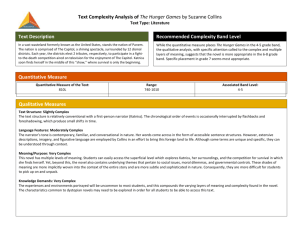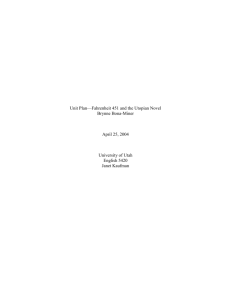UTOPIAN AND DYSTOPIAN FICTION - From
advertisement
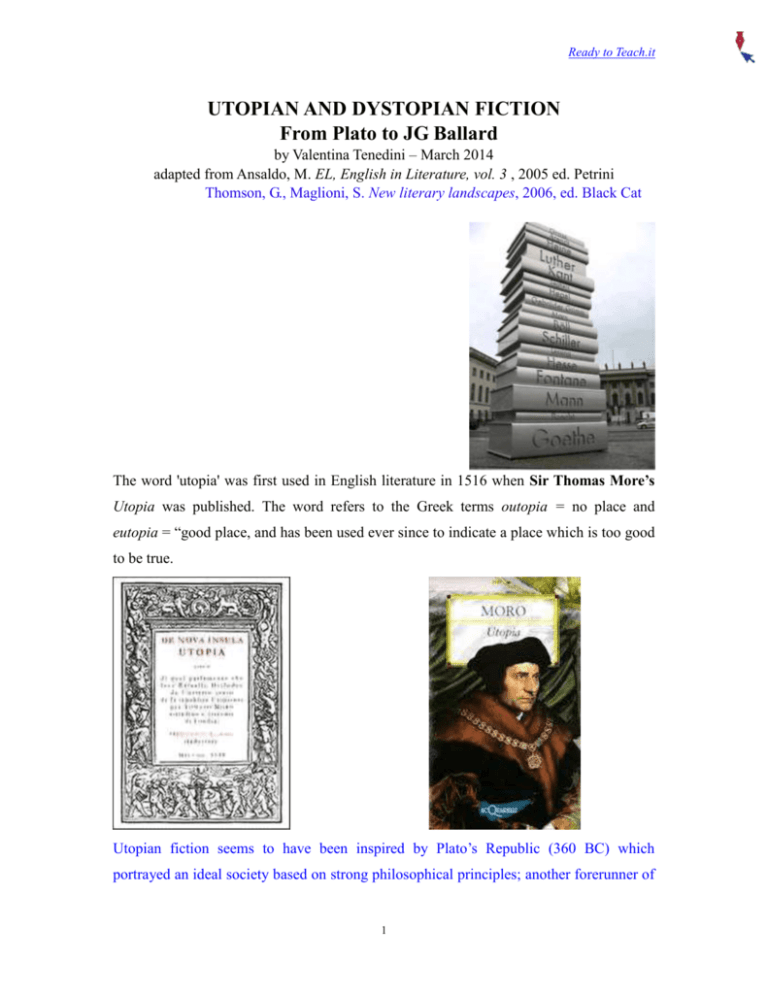
Ready to Teach.it UTOPIAN AND DYSTOPIAN FICTION From Plato to JG Ballard by Valentina Tenedini – March 2014 adapted from Ansaldo, M. EL, English in Literature, vol. 3 , 2005 ed. Petrini Thomson, G., Maglioni, S. New literary landscapes, 2006, ed. Black Cat The word 'utopia' was first used in English literature in 1516 when Sir Thomas More’s Utopia was published. The word refers to the Greek terms outopia = no place and eutopia = “good place, and has been used ever since to indicate a place which is too good to be true. Utopian fiction seems to have been inspired by Plato’s Republic (360 BC) which portrayed an ideal society based on strong philosophical principles; another forerunner of 1 Ready to Teach.it the utopian genre may have been Columbus’s journey to Americas in 1492, whose land was seen as a second Eden and thus the ideal territory to establish a new society. The most famous utopian fantasies apart from More’s Utopia, is Francis Bacon ‘s New Atlantis, and Tommaso Campanella La città del sole (1602). More‘s Utopia is an island where there is no private property, which is considered the origin of all the evils of society. People live sharing all goods, education and medical treatment are free whereas all religions are tolerated; people work for six hours only so as to have enough time for relaxation and entertainment. Laws are kept to a minimum and are so simple that everyone can understand them and respect them. With his work More gave origin to a new literary genre, dealing with imaginary places in which everything is perfect and which are in contrast with the world of reality. The next utopian work was The New Atlantis, by Francis Bacon, which was published in 1626. It describes a completely isolated society which has complete nature control, where people use devices suggesting the future development of airplanes, submarines and telephones among other fantastic achievements. In the 18th century the most famous utopian writer was Jonathan Swift with his famous Gulliver’s Travels (1726), which was a masterpiece of the so called semi-utopian narrative. The use of this term derives from the fact that of the four types of worlds described in the book only one seems to be truly utopian, the one ruled by the Houyhnhnms, talking, intelligent horses. The other three, Lilliput, (the land of tiny 2 Ready to Teach.it people), Brobdinag (the country of giants) and Laputa (the island of scientists and philosophers), cannot be regarded really as utopian societies because they are characterized by both positive and negative aspects. Gulliver’s travels has been classified as a book for children, a novel of the fantastic, a parody of travelbooks, however it is a satirical book which attacks civilized man’s hypocrisy, vanity, cruelty, small-mindedness and absurd pretensions. The utopian genre became popular again during the 19th century, among Victorian social reformers, with 2 novels: Erewhon, an anagram of "nowhere", published in 1872 by Samuel Butler which tells the story of a young traveller who discovers the land of Erewhon, a society based on the tyranny of health and physical fitness, ruled by dangerous philosophers and prophets, which the author attacks with deep satirical spirit. This novel marks the beginning of the reversal of utopias into dystopias; and News from Nowhere (1890) by W. Morris where the protagonist / narrator falls asleep in a London suburb, and wakes up in the future finding London transformed into a communist paradise after a successful revolution; (private property do not exist, there is free education, religious tolerance, gender equality, a state of peaceful and functional anarchy where everybody studies according to his/her ‘turn of mind’ and does the job he/she likes). 3 Ready to Teach.it The turn of the century saw a great proliferation of utopian works. Most of them were technological utopias in which man enjoyed pleasant leisure while work was done by obedient machines. As most of these novels dealt with science and its applications in imaginary worlds, they were also called science fiction. The most distinguished example is The Time Machine (1895), by Herbert George Wells which introduces in comic pseudo-scientific discourse, a technological means of travel through time. It deals with the theme of confrontation with the alien, of the last man on earth and of the death of the world. Wells wrote a number of utopian novels, the most important seems to be A Modern Utopia (1905), in which the author conceives utopia as a world state, with international government, central bureaucracy, state-controlled land, capital and industry and population control. This global utopia is ruled by a voluntary nobility called "Samurai". But the 20th century historical events, such as cold and hot wars, revolutions, civil wars, and totalitarian regimes, have 4 Ready to Teach.it weakened the belief in the perfectibility of mankind. In addition to that it must be noted that utopian novels, above all the ones which celebrate scientific and technological progress, produced a reaction in writers who criticized the impact of those on a world more and more technologically and scientifically regulated, which was seen more as a threat than as a promise. The logical fear produced by such view gave origin to anti-utopian or dystopian fiction, where fantastic worlds are described which are disturbing and scary rather than ideal. The archetype of the modern dystopian novel is the Russian Ygeny Zamyatins’s We, (written in 1920-1, first published in English in 1924 - translated into several languages and banned from publication in Russia until 1988) a satire on early post-revolutionary Russia envisaging a regimented totalitarian society of OneState ruled over by the all-powerful ‘Benefactors’, a new order in which every aspect of life is controlled and the people are called by numbers. The novel shows the likely consequences of surrendering our individuality to some collective technological dream and forget that caution is the price of freedom. This novel provided enormous inspiration for G. Orwell. Anti-utopian novels are usually set in the future so that they can be interpreted as warnings to men because if they do not change their behaviour and their attitudes the society devised in the novels will come true. 5 Ready to Teach.it The wittiest and most urbane dystopian fantasy is Brave New World (1932) by Aldous Huxley, a speculative analysis of the logical consequences of the western technocratic societies. The story is set 600 years into the future (in the era of Ford – the owner of the popular American automobile industry, who perfected the assembly line) in a world where society is organized in a scientifically controlled caste system, where people’s intellectual and social abilities are genetically programmed and individuals are born artificially from incubators. Fear of both natural elements and books is induced since very young age, while people are kept artificially happy with the use of legal drug called ‘soma’. The book is a warning against the dangers of scientific developments and dictatorship, the worst result of which can be the loss of freedom and of one’s own identity. 6 Ready to Teach.it Another dystopian work dealing with the themes of liberty and individuality destruction is Animal Farm (1946) by George Orwell. It is a satire about life in an animal community under an animal dictatorship and it is a strong criticism of any form of totalitarianism. lt was followed by Nineteen eighty-four (1949), that is both a commentary on the rise of totalitarian regimes of the 1930s and 1940s, and in some way prophetic of today’s mass-media dominated world. 7 Ready to Teach.it It presents life under Big Brother’s dictatorship, and a vast hierarchy under him represented by 'The Party'. There is no privacy and unorthodox ideas are punishable by law. The despot is never seen and there is no certainty he really exists; people are under the constant surveillance of tele-screens. A large part of the story reads like a spy thriller: there is a love affair between a man and a woman who plot against 'Big Brother', but they are betrayed by a member of the Secret Police. After being tortured, the two lovers denounce each other, they are brainwashed so they embrace conformity to the system. The message is unmistakable: not only is dictatorship a permanent threat to the political future of mankind, but it also represents a danger for individual psychological freedom because of its manipulation on people's minds. ln the years that followed many writers were influenced by the dystopian genre and in their works they devised societies which expressed their horror of the present and their fear for the future of mankind. Farenheit 451 by Ray Bradbury (1953), is one of them and deals with the themes of information manipulation, censorship and defiance; the novel shows a future world where ‘books are for burning’; the protagonist Guy Montag, a fireman whose job consists of starting fires, never questions his work or anything until he meets a girl who tells him of a past where people were not afraid and meets a professor who tells him of future where people can think. (Like in many other dystopian works Bradbury's novel deals with the themes of personal freedom and loss of one's own individuality, and presents a society where the ability to read, that is to think for oneself, is seen as a threat to the system). 8 Ready to Teach.it Another dystopian novel is William Golding’s Lord of the Flies (1954), in it a group of children are evacuated from Britain to escape a nuclear war; after a plane crash, they are stranded on a desert island where - in the attempt of creating the world of adults - and despite living in a 'the state of nature' - they gradually become violent savages. The novel is considered dystopian since the story is set in the future and the author seems to maintain that society shape depend on the ethical structure of the individual and not on any political system, while democracy is constantly challenged by the innate savagery in human nature. A post-modernist practitioner of the dystopian genre was J.G. Ballard (1930-2009) whose novels: The Wind From Nowhere – 1962, The Atrocity Exhibition (the latter dealing with themes such as the Vietnam war, psychopathology, pornography, mass media power), Crash - to name but a few - show worlds where the power of technology gradually 9 Ready to Teach.it reshape the people’ psychology, while they come to adapt to the new environmental conditions with unexpected, frightening outcome. SUGGESTED ACTIVITIES PRE-READING SPEAKING 1)Show the following pictures and elicit students' comment 2) provide information about each photo on this page gradually, so as to elicit further comment (keys on the NEXT PAGE) 10 Ready to Teach.it “That was just a prelude, where books are burnt, people will be burnt”. POST READING ACTIVITIES 2) READING comprehension 1 give a schematic outline of the utopian and dystopian genre (authors – work – date) 2 identify the main feature of utopian/dystopian works 3 Find out similarities and differences, and think what may be the reason for them, also in the light of their historical context. 3) WRITING - ZOOM IN Think of the utopian / dystopian novels you have read. Focus on the role that reading, writing and language have in them. Draw your own conclusion on the author's aims with regards to those aspects. Practical tip for carrying out the lesson: the students can be given only the shorter version, while the photos o f the extended version can be used as prompts during the students interviews. KEYS: The book burning memorial - Babelplatz Berlin – 1995 Library The art work of the Israeli artist Micha Ullman features underground empty bookshelves with the room for about 20,000 books –a reference to the approximately 20,000 works by journalists, writers, scientists and philosophers, which were burnt on May 10th, 1933 in this square. Next to the memorial a plaque with a quote from the play Almansor ( 1821) by Heinrich Heine (1797-1856) reads: 11 Ready to Teach.it “That was just a prelude, where books are burnt, people will be burnt”. 12
